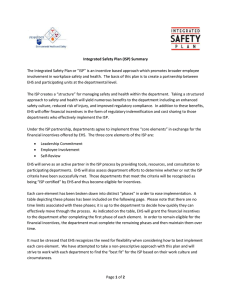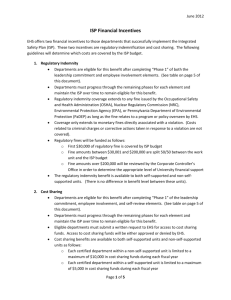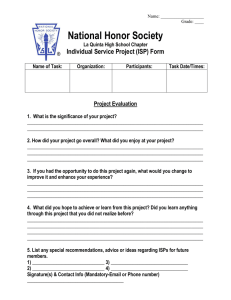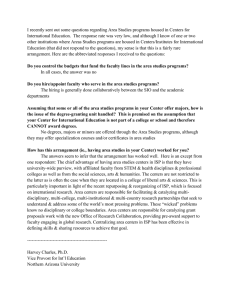ISP Financial Incentives
advertisement
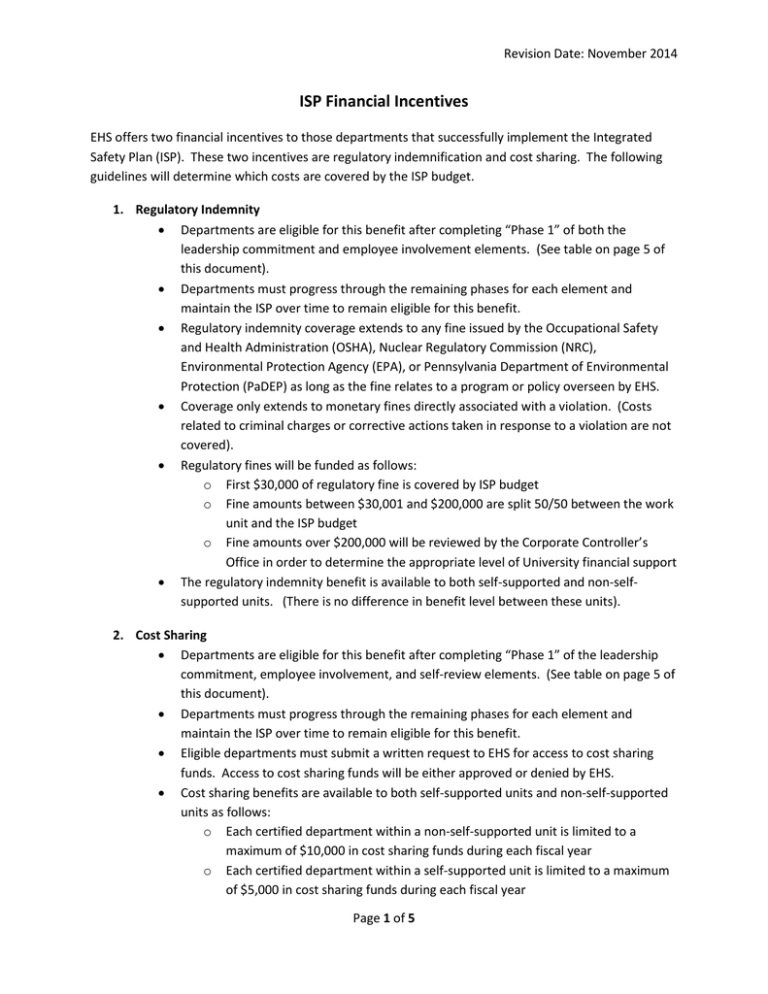
Revision Date: November 2014 ISP Financial Incentives EHS offers two financial incentives to those departments that successfully implement the Integrated Safety Plan (ISP). These two incentives are regulatory indemnification and cost sharing. The following guidelines will determine which costs are covered by the ISP budget. 1. Regulatory Indemnity Departments are eligible for this benefit after completing “Phase 1” of both the leadership commitment and employee involvement elements. (See table on page 5 of this document). Departments must progress through the remaining phases for each element and maintain the ISP over time to remain eligible for this benefit. Regulatory indemnity coverage extends to any fine issued by the Occupational Safety and Health Administration (OSHA), Nuclear Regulatory Commission (NRC), Environmental Protection Agency (EPA), or Pennsylvania Department of Environmental Protection (PaDEP) as long as the fine relates to a program or policy overseen by EHS. Coverage only extends to monetary fines directly associated with a violation. (Costs related to criminal charges or corrective actions taken in response to a violation are not covered). Regulatory fines will be funded as follows: o First $30,000 of regulatory fine is covered by ISP budget o Fine amounts between $30,001 and $200,000 are split 50/50 between the work unit and the ISP budget o Fine amounts over $200,000 will be reviewed by the Corporate Controller’s Office in order to determine the appropriate level of University financial support The regulatory indemnity benefit is available to both self-supported and non-selfsupported units. (There is no difference in benefit level between these units). 2. Cost Sharing Departments are eligible for this benefit after completing “Phase 1” of the leadership commitment, employee involvement, and self-review elements. (See table on page 5 of this document). Departments must progress through the remaining phases for each element and maintain the ISP over time to remain eligible for this benefit. Eligible departments must submit a written request to EHS for access to cost sharing funds. Access to cost sharing funds will be either approved or denied by EHS. Cost sharing benefits are available to both self-supported units and non-self-supported units as follows: o Each certified department within a non-self-supported unit is limited to a maximum of $10,000 in cost sharing funds during each fiscal year o Each certified department within a self-supported unit is limited to a maximum of $5,000 in cost sharing funds during each fiscal year Page 1 of 5 Revision Date: November 2014 The following table provides reimbursement rates for specific items. Reimbursement rates for items not specifically listed will be determined by EHS: ISP Cost Sharing Coverage Item Significant safety upgrades based on new information or technology Fall protection in elevated locations Machine guarding Eyewash/safety showers Flammable liquid storage cabinets University-wide safety training needs Medical surveillance Hepatitis B vaccinations required by OSHA Bloodborne Pathogens Standard Fall protection equipment Confined space entry equipment Personal protective equipment (PPE) Professional development % Funded Facility Needs 50% up to $2000 50% of permanent rails, anchor points, temporary railing systems, or utility carts 50% up to $2000 Comments Examples would be HEPA filters for nanotechnology based on new information from NIOSH or CSHEMA; alarm monitoring for a hazardous operation; etc. Central funding source exists for installation of roof systems Installation of covers, interlocks, light curtains, etc. 50% up to $3000 50% up to $1000 Departmental Safety Needs Cover 100% of initial training; 50% of ongoing training Cover 100% of initial medical surveillance (i.e. first test for each affected employee over three year period) 100% 50% up to $4000 50% up to $4000 for equipment or engineering solution 50% up to $4000 50% up to $4000 Page 2 of 5 Powered industrial trucks, electrical safety, fall protection, etc. Hearing tests, respirator medical clearances, etc. Harnesses, lanyards, etc. Retrieval equipment, harnesses, portable gas monitors, etc. PPE needs which impact entire department, not individual Safety courses for safety officers, supervisors, etc. Revision Date: November 2014 Guidelines and Procedure for Requesting ISP Cost Sharing Funds General Guidelines: 1. Departments who have been “certified” as meeting the ISP criteria by EHS may request access to cost sharing funds. 2. Cost sharing funds shall be administered by the EHS Department. 3. Cost sharing funds may be used for a wide variety of health, safety, and environmental compliance activities. However, in general, cost sharing is not intended to cover the following: a. Facility repair and rehabilitation b. Incidental supplies and expenses c. Travel d. Replacement of obsolete equipment e. Equipment repair or upgrades f. Research start-up g. Wages 4. Minor department-related costs, generally less than $100 per item, shall be borne by individual departments. Requests for funds to correct major deficiencies, such as repair and rehabilitation projects, should be submitted through established channels. Procedure for Requesting ISP Cost Sharing Funds: 1. Contact the Occupational Health and Safety Manager at 865-6391. 2. The Occupational Health and Safety Manager will give further advice on the appropriateness of the request for cost sharing and assist with potential solutions to the issue. 3. The “ISP Cost Sharing Request” form will initiate the process to request funds. Complete and submit this form to EHS. 4. Attach all appropriate supporting documentation to the form such as estimates, quotes, part numbers, and ordering information. 5. After the request is evaluated, you will be notified by EHS if it has been approved and how to proceed. Page 3 of 5 Revision Date: November 2014 ISP COST SHARING REQUEST FORM Date: __________________________ Total Cost of Expenditure: ___________________________ Department: ____________________ Amount of Cost Sharing Requested: ___________________ Campus: ________________________ Requested By: ____________________________________ ISP Contact: _____________________ Requestor Phone: _________________________________ Safety Officer: ___________________ Requestor E-Mail: _________________________________ Budget Number to Be Reimbursed: __________________________________________ Financial Officer Name: ____________________________________________________ Financial Officer E-mail Address: _____________________________________________ -----------------------------------------------------------------------------------------------------------------------------------------Description of Expenditure: (Attach supporting documentation such as estimates, quotes, part numbers, and ordering information) -----------------------------------------------------------------------------------------------------------------------------------------Justification for Expenditure: Hazard (Describe the specific hazards to be mitigated by this expenditure) Compliance Issue (Provide explanation of compliance issue) ------------------------------------------------------------------------------------------------------------------------------------------ EHS Approval Signature: ___________________________ Page 4 of 5 Date: __________________ Revision Date: November 2014 ISP Core Element and Phase Breakdown Phase 1 Phase 2 Leadership Commitment 1) Visibly demonstrate leadership commitment to workplace safety and health 2) Clearly assign and communicate safety responsibilities to all employees 3) Ensure leadership is aware of relevant injury & illness statistics 1) Implement system for ensuring employee responsibilities are met 2) Integrate safety into planning processes 3) Periodically establish safety goals and metrics for department Employee Involvement 1) Establish a departmental safety committee that effectively represents all employees 2) Develop mechanisms through which all employees can effectively communicate safety concerns & offer suggestions for safety-related improvements 1) Allow employees opportunities for direct involvement in safety efforts Self-Review 1) Identify general safety issues which impact department 1) Identify program gaps 2) Prioritize program gaps and develop implementation strategy for addressing 3) Close program gaps Completion of Phase I “Leadership Commitment” & Phase I “Employee Involvement” items = Department eligible for indemnity Completion of all Phase I items = Department eligible for cost sharing Completion of all Phase II items = Department continues to remain eligible for indemnity & cost sharing Page 5 of 5
